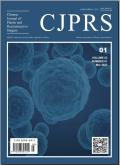Acute traumatic extratemporal facial nerve injury: A 5-year review
Chinese Journal of Plastic and Reconstructive Surgery
Pub Date : 2024-12-01
DOI:10.1016/j.cjprs.2024.08.004
引用次数: 0
Abstract
Background
Traumatic facial nerve injury is the second leading cause of facial paralysis, presenting significant challenges such as difficulties with eating, speaking, impaired vision, and loss of facial expression. Understanding these injuries is critical for plastic surgeons to optimize recovery and functional outcomes. This study examined our experience with acute traumatic extratemporal facial nerve injuries, focusing on their characteristics, the frequency of affected nerve branches, and identification using Seckel’s facial danger zones as anatomical landmarks. We also explored the implications of surgical management based on the current literature and our experience.
Methods
We reviewed 50 patients with acute traumatic extratemporal facial nerve injuries treated at Hospital General Dr. Manuel Gea González in Mexico City from January 2019 to January 2024. The collected data included demographics (age, sex, severity, and time to medical attention), injury mechanism, affected nerve branches using Seckel’s zones, and treatment methods.
Results
The majority of the patients were male (82%), with an average age of 29 ± 16 years. Sharp trauma from assault was the most common cause (66%). The buccal and frontal branches were most frequently affected, with Seckel zones IV and II involved in 46.86% and 33.33% of cases, respectively. Primary neurorrhaphy was performed in 96% of the patients.
Conclusion
The effective management of traumatic facial nerve injuries relies on understanding the characteristics of the injury and using anatomical landmarks for prompt localization. Primary neurorrhaphy is the preferred surgical approach, with nerve grafting being an alternative. Ideally, early intervention within 72 h is crucial for optimal nerve recovery.
急性外伤性颞外面神经损伤:5年回顾
外伤性面神经损伤是导致面瘫的第二大原因,它会带来严重的挑战,如进食困难、说话困难、视力受损和面部表情丧失。了解这些损伤对整形外科医生优化恢复和功能结果至关重要。本研究考察了我们对急性外伤性颞外面神经损伤的经验,重点关注其特征、受影响神经分支的频率,以及使用Seckel面部危险区作为解剖标志的识别。我们还根据目前的文献和我们的经验探讨了手术治疗的意义。方法回顾性分析2019年1月至2024年1月在墨西哥城总医院Manuel Gea博士González治疗的50例急性创伤性颞外面神经损伤患者。收集的数据包括人口统计数据(年龄、性别、严重程度和就医时间)、损伤机制、使用塞克尔区受影响的神经分支和治疗方法。结果患者以男性居多(82%),平均年龄29±16岁。攻击造成的尖锐创伤是最常见的原因(66%)。颊支和额支最常受累,Seckel IV区和II区分别占46.86%和33.33%。96%的患者行原发性神经缝合术。结论了解外伤性面神经损伤的特点,利用解剖标志及时定位是治疗外伤性面神经损伤的有效方法。原发性神经吻合是首选的手术方法,神经移植是另一种选择。理想情况下,72小时内的早期干预对于最佳的神经恢复至关重要。
本文章由计算机程序翻译,如有差异,请以英文原文为准。
求助全文
约1分钟内获得全文
求助全文
来源期刊

Chinese Journal of Plastic and Reconstructive Surgery
Surgery, Otorhinolaryngology and Facial Plastic Surgery, Pathology and Medical Technology, Transplantation
CiteScore
0.40
自引率
0.00%
发文量
115
审稿时长
55 days
 求助内容:
求助内容: 应助结果提醒方式:
应助结果提醒方式:


